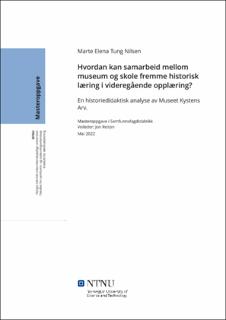| dc.description.abstract | Den overordnede problemstillingen for denne masteroppgaven er: «Hvordan kan samarbeid mellom museum og skole fremme historisk læring i videregående opplæring?» Museum er for lite brukt i undervisningen i dag. Derfor vil denne masteroppgaven ha et historiedidaktisk syn på hvordan museum kan brukes i historieundervisningen i videregående opplæring. Ved å ta utgangspunkt i Johan Bojer videregående skole og Museet Kystens Arv som i dag har et begrenset samarbeid vil oppgaven svare på spørsmål slik som; på hvilken måte kan et skolebesøk til museum være vellykket, hvilke forventninger har institusjonene til hverandre og hvilke virkemidler kan brukes for å utvikle historisk læring blant elevene?
Med nye læreplaner kommer også nye begreper. Derfor vil oppgavens teoretiske grunnlag bli lagt i begrepene ‘historiebevissthet’ og ‘historisk empati’ som har en sentral rolle i Fagfornyelsen. Ut ifra dette kommer også begreper slik som ‘kulturarv’, ‘identitet’ og ‘lokalhistorie’ til å dukke opp. Med det empiriske materialet lagt i to dybdeintervjuer med en lærer og en museumspedagog.
Forskningsfeltet innenfor samarbeidet mellom skole og museum er lite undersøkt, og gjennom mitt prosjekt vil feltet få nye innfallsvinkler i hvordan den nye læreplanen fra 2020 oppfordrer til slike samarbeid. Gjennom vandreteater, båtbyggeri, utstillinger og blåe låvedører lærer elevene kulturarv, identitet og lokalhistorie, og dermed utvikler sin historiebevissthet og historiske empati. | |
| dc.description.abstract | The overall research question for this master’s thesis is: “How can a partnership between museums and schools promote historical learning in the Norwegian upper secondary education?” Museums in Norway are barely used for educational purposes during the school day. Therefore, this master’s thesis will have a history didactic view on how museums can be used in history teaching. By researching Johan Bojer upper secondary school and the Coastal Heritage Museum, which today has a limited partnership, the thesis will answer questions such as: In what way can education at the museum be successful, what expectations do the museum and the school have to each other, and which methods can be used to develop historical learning among students?
In 2020 new curriculums were introduced in Norway, Fagfornyelsen. With the introduction also new concepts and terms were introduced. Therefore, the theoretical basis of the thesis will be laid in the concepts of ‘historical consciousness’ and ‘historical empathy, which have a central role in Fagfornyelsen. Based on this, concepts such as ‘cultural heritage’, ‘identity’, and ‘local history’ also become relevant. The empirical material is two in-depth interviews with one teacher and a museum educator.
The field of research within the partnership between school and museums are not developed fully in Norway. Through my project, the field of research will gain new perspectives on how the new curriculum from 2020 encourages the partnership between museums and schools. Through walking theatre, boat building, exhibitions, and “blue barn doors”, students learn about cultural heritage, identity, and local history, and thus develop their historical consciousness and historical empathy. | |
